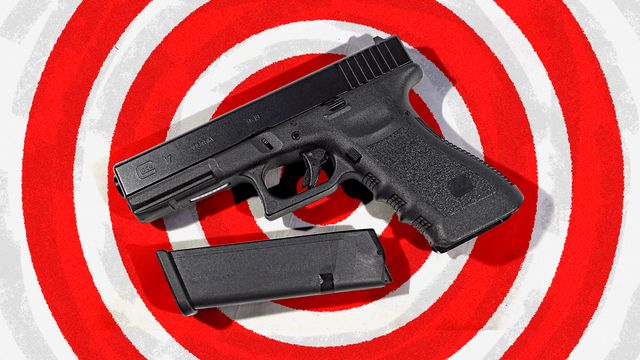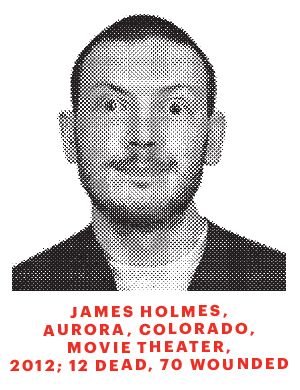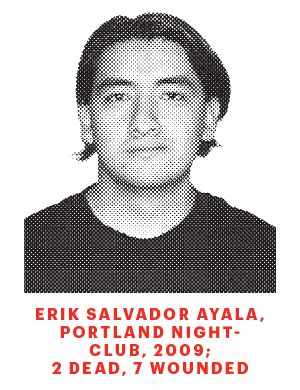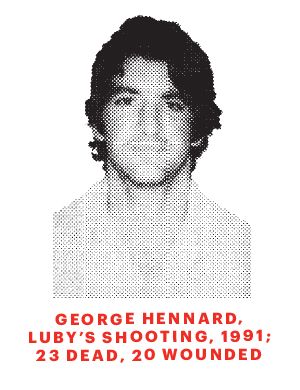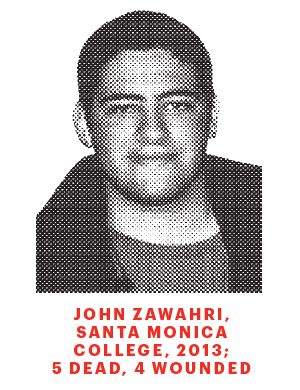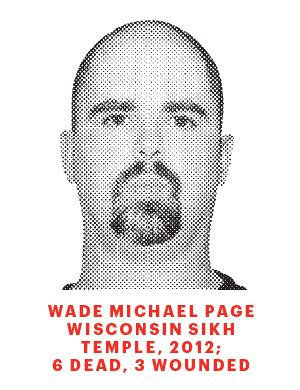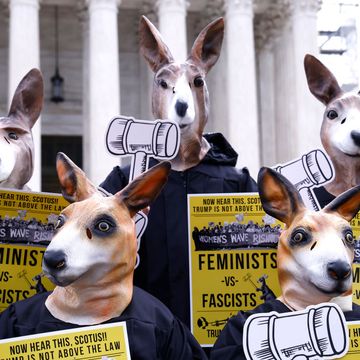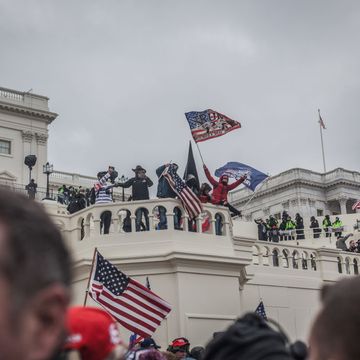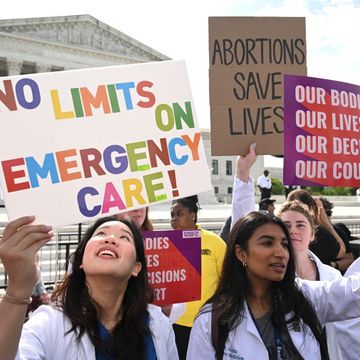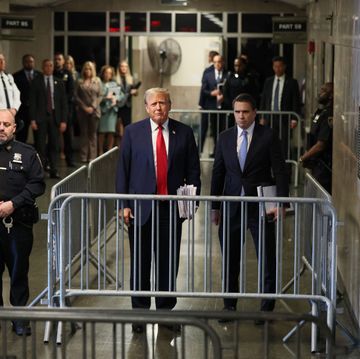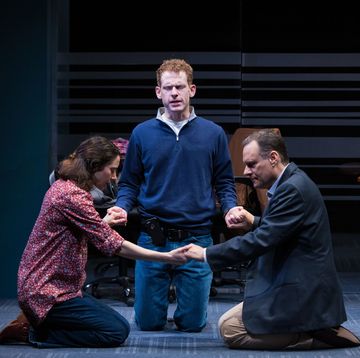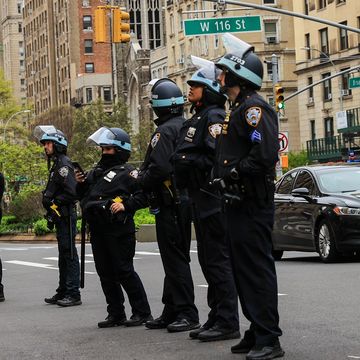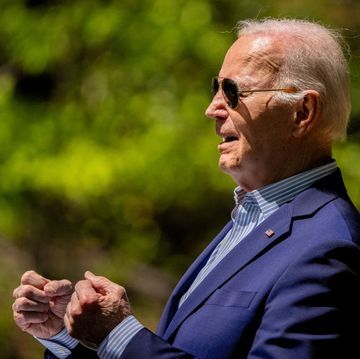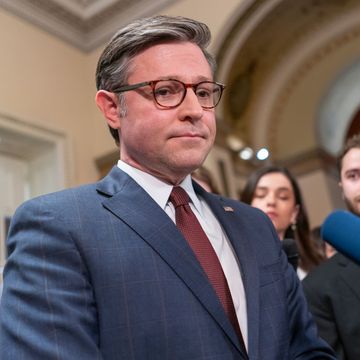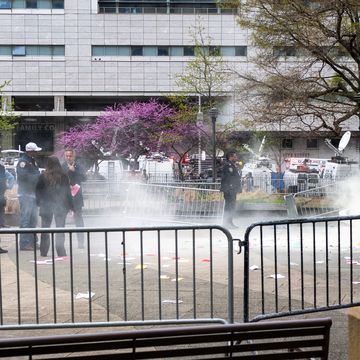Editor's note: This story was originally published in the October 2014 issue of Esquire.
Nobody knows who he is and nobody knows who he was. When he was a young man—a boy, really—his anonymity fueled his desperation, and for a short time his desperation made him known. He didn't become famous the way other desperate and aggrieved young men have, but he made himself well-known enough to think that when he came home after eight and a half years in prison, there might be cameras waiting for him on his front lawn and people interested in asking him questions. There weren't. There was just his family and the rest of his life.
So Trunk—a nickname he acquired when he went away—has returned to where he started out. He couldn't be more unknown. He couldn't be more anonymous. On the days he goes to college, he takes a bus. He walks a half hour to the bus stop, no matter the weather. He walks in the heat, he walks in the cold, he walks in the rain, he walks in the snow. The bus ride takes another forty-five minutes, and when he gets to the school, it's also an anonymous affair—a small college attached to a state system and situated a long way from any major highway. He doesn't care; he works hard at his studies and his academic record is immaculate. He has ambitions. He has friends. He does not mind being anonymous or feeling alone, because he feels accepted and has accepted himself. "The last year and a half, everything is as it's supposed to be," he says. "I have zero feelings of societal frustration."
Trunk does, however, think often of the person who is out there right now feeling the way he used to feel. The person with a grievance. The person with a plan. The person with a gun—hell, an arsenal. The person we feel powerless against, because we don't know who he is. All we know is what he—or she—is going to do.
Can he or she—they—be stopped before they become what we in America call "mass shooters"? We are so convinced they can't be that we don't even know if anyone is trying to stop them. Can they be understood? We are so convinced the evil they represent is inexplicable that we don't try to explicate it. Mass shootings have become by now American rituals—blood sacrifices, propitiations to our angry American gods, made all the more terrible by our apparent acceptance of them. They have become a feature of American life, and we know very well what follows each one: the shock, the horror, the demonization of the guilty, the prayers for the innocent, the calls for action, the finger-pointing, the paralysis, and finally the forgetting. We know that they change everything only so that everything may remain unchanged.
But we are wrong about that. Mass shootings are not unstoppable, and there are people trying to stop them. They are not even inexplicable, because every time Trunk hears of one he understands why it happened and who did it. We have come to believe that mass shooters can't be stopped because we never know who they are until they make themselves known. But Trunk was almost one of them once. He was a heartbeat away. And what he understands is that shooters want to be known, not through the infamy of a massacre, but before they have to go through with it. They want to be known as much as he, years later, wants to remain unknown, walking to the bus stop in the rain.
The outside of the building is nondescript by design. It is brown and it is brick, with darkened windows and reflective glass in the doors. It could be anywhere, and it could be used for anything—office rental, warehouse space, light industry, government bureaucracy, apocalyptic bunkering. The inside is no different. The only indication that the building is used for anything other than midlevel marketing are the two flags given prominence of place. The flags fly the colors of the United States of America and of the Federal Bureau of Investigation.
In an anonymous conference room inside the anonymous building, a man sits at the head of the conference table. His name is Andre Simons. He is trim, compact, and alert, with a scalp shaved to a high shine, arched eyebrows, and preternaturally wide-open eyes. He has seen a lot, heard even more, and suggests, by his demeanor, that he knows just about everything—everything, that is, but the one haunting and humbling thing he really needs to know.
Simons is the answer to the question who is trying to stop "the next one"—the next active shooter, the next act of targeted violence, the next mass killing. Within the FBI's Critical Incident Response Group, there exists the National Center for the Analysis of Violent Crime; within the NCAVC, there are the Behavioral Analysis units, made famous by movies and television for profiling serial killers. Behavioral Analysis Unit 1 concerns itself with counterterrorism; Behavioral Analysis units 3 and 4 with crimes against children and crimes against adults. Simons is in charge of Behavioral Analysis Unit 2, which assesses threats. This sounds like an impossibly broad category of endeavor, but in fact it's quite specific. "Threat assessment" is just now becoming such a formal discipline that Simons describes himself and the members of his team as "threat-assessment professionals." It is becoming such an accepted practice that its practitioners refer to it as TA for short and have their own professional organization and scholarly journal. And, although very few people know what it is, threat assessment has been America's best and perhaps only response to the accelerating epidemic of active shooters and mass shootings, with Andre Simons foremost among the federal officials trying to implement it on a national level.
Three or four times a week, Simons meets with his colleagues from BAU2 in the same conference room where he now sits, and together they try to decide if a person who has been brought to their attention—a person of concern—is on what they call "the pathway to violence" or is planning an attack.
"If a person who is out there right now planning a violent act comes to the attention of people around him or her—and I'll deliberately say him or her because even though the odds are that it will be a male, there have been female attackers as well—and we think they're contemplating an act of violence or planning an active shooting, then we're going to implement various strategies to mitigate that risk. So we in the FBI are constantly working with local, state, and campus police, as well as other federal agencies, to try to figure out who that person is and how we can prevent that from happening. If that person is out there—and we believe, certainly, that there is someone out there right now who, if they're not actively planning, then they're at least contemplating that type of act—then how can we leverage all of the resources available to us, whether in mental health or in law enforcement, to identify, assess, and manage that person?"
This is the language of threat assessment, and it is no more colorful than the surroundings in which it's typically spoken. It is not simply full of hedged bets and mitigated risks; it is, in itself, a hedged bet and a mitigated risk. Yet, like Andre Simons, threat assessment carries a force that transcends its immediate circumstances. A hedged bet is a bet all the same, and the bet that threat assessment makes is the same bet we've been making as a country for the last half century—a bet against the existence of evil.
Active shooters, mass shooters, rampage killers, whatever you want to call them: They have supplanted serial killers and possibly even terrorists as our culture's symbol of ultimate evil, seen as unfathomable and hence unstoppable. Part of the shock of any mass shooting is the powerlessness and helplessness we feel in its wake—our inability to answer with anything more than stuffed animals and futile politics.
And so when you talk to people who do threat assessment, it is hard not to be struck by how confident they are, given the steady drumbeat of public slaughters. Even more remarkable, when you start researching the question of what the United States is doing to stop mass shootings, is the degree to which the arena has been turned over to them. Threat assessment is not just the best we've got; it's all we've got. The question that remains is why, if threat assessment is so effective, so many still end up dead.
Trunk could be anyone from anywhere. He could be a boy or he could be a man. When you look at him, you see somebody's son; when you look at him again, you see a photograph on the front page of a newspaper. He could be both. He has been both. He has blond hair and wears glasses with wire frames and a thin chain around his neck; his skin is extraordinarily pale, except for some pink in his cheeks and some darkness in the dents under his eyes. The only thing in any way remarkable about him is the extent to which he's been preserved. He is thirty; he could easily pass for twenty, and not just physically. He has never driven a car. His hands are not merely uncalloused—they look larval, as if they have never been exposed to light. They are white as paint. His fingers are long and thin, and so are his fingernails, which are the color of pearls.
Eleven years ago, he was arrested with a military-grade rifle slung on his back, a .22-caliber pistol in his belt, a machete, and two thousand rounds of ammunition. He was dressed in black and so were his two accomplices, who were similarly armed. To avoid charges of conspiracy and weapons possession, he pleaded guilty to carjacking and was sentenced to ten years of what he calls "hard time." In prison, he had a nickname: Trunk Full of Guns.
"It wasn't a bad nickname to have," he says, "because people thought I might be crazy and gave me a wide berth." Prison is what preserved him; it is also, in his opinion, what saved him, despite its rigors and hardships. "I was forced to learn social skills in jail. I'd never had the experience of talking to other people. In jail, I had no choice. If you don't know how to talk to people, you get crushed."
He also became reflective, especially when the prison television showed whoever the latest shooter was, fresh from the latest massacre. Sure, he was Trunk Full of Guns. But was he one of them? Was he a psychopath? He didn't think so. He had come as close as a human being could possibly get to abandoning his humanity. But he hadn't. He wasn't, well, evil. And he didn't think that even the most prolific shooters necessarily were, either. He knew them—he knew what they had gone through because of what he had gone through. The pathway to violence: That wasn't just a term of threat assessment. He didn't know what threat assessment was. But he had been on the pathway and remembered its milestones. And so when he got an e-mail asking if he had any ideas about stopping mass shootings, he volunteered to talk. He didn't just have ideas; he wound up doing a kind of threat assessment on his former self, if only so that people might be able to assess the threat—and yes, the humanity—of people like him.
How did it start? He wanted to say that it started with pain. He wanted to say that it started with suffering. He wanted to say that it started when he was a little kid and his mother wouldn't let him play with other little kids. He wanted to say that it started when he was just ten years old and she died. He wanted to say that it started when he had to repeat seventh grade. But nobody wants to hear that. And anyway, it was all wrong. It didn't start with anything anyone else did. It started with something he did. It started with a thought.
"I'd be lying in bed wondering what I was doing wrong. Why didn't anybody like me? Why was everybody against me? I could have thought, Well, I'm a loser. But I didn't want to think that. So I started thinking they were losers. I started thinking that they didn't like me because they were afraid of me—because I had power and they didn't. Because I was special. And that's when it all really got started:
"When I began thinking I was special."
Since September 11, 2001, according to the START terrorism database, there have been twenty lethal terrorist attacks in the United States, resulting in the deaths of forty-six people. There have been, at most, a handful of assassinations. According to the FBI, from 2001 to 2011, there have been nearly 250 mass shootings, defined as the death of four or more people. According to USA Today, whose data on mass shootings is considered at least as reliable as the FBI's, there have been 191 mass shootings since 2006, with 34 described as "public" shootings—seemingly random events, stranger to stranger. Nearly a thousand people have died; many more have been wounded. What America feared after the 9/11 attacks—that it would be perpetually attacked by outsiders calling themselves Americans—finally has transpired, only with an awful twist: It is perpetually attacked by Americans who call themselves outsiders.
There have always been mass shootings, especially in schools and workplaces, where someone with a gun can settle scores real and imagined. Since Columbine, however, mass shootings have evolved, becoming less intimate, less local, and in some ways less understandable. Columbine combined the school shooting with a purposeful act of theater. Columbine was meant to be spectacular, and it has beckoned mass shooters ever since as an example, a template, and a challenge. They study it, and they try to top it in terms of either body count or showmanship. From suicidal ideation grows the delusion of grandeur; from the desire to kill yourself grows the desire to kill as many people as possible, with immortality on the line. It doesn't matter if they are complete strangers; the goal is to expire in a chaos of your own creation, with you the only one in control, your everlasting infamy ensured by the videos, manifestos, and "legacy tokens"—the coded public farewells—you leave behind.
It sounds like terrorism. It is terrorism in that it is meant to terrorize. But that doesn't mean that shooters can be considered terrorists or investigated as such. For one thing, they don't fit the definition: "The active shooter," says Andre Simons, "tends more often than not to be motivated by a deeply personal grievance tinged with feelings of persecution and humiliation, real and perceived, whereas terrorists are oftentimes going to be motivated by more ideological reasons." For another, they are almost without exception American citizens, which is one of the reasons terrorism stirs and shootings sap national resolve. We have become so familiar with the techniques used against the threat of terrorism—the surveillance, the data mining, the network analysis, the stings making use of confidential informants—that it is tempting to think that they could be applied to the threat of, well, threat, in the TA sense of the word. If someone is making threats on the Internet and is obsessively enacting the role of shooter in online games and has a history of mental illness and is buying large numbers of firearms or ammunition, then surely the power of simple correlation should identify him before he acts.
Except that it doesn't. It can't. Plenty of people do all of those things without deciding to shoot anybody. Shootings are so statistically infrequent that no predictive algorithm can claim to see them coming. The Internet is such a vast world of threat that Michelle Keeney, who heads the Secret Service's National Threat Assessment Center, describes the information that pours into her office as "a firehose" and says, frankly, "we don't know what to do with it." Furthermore, medical-confidentiality laws are such that Ray Kelly, the former commissioner of the New York Police Department, calls the mentally ill "the last truly private people in America."
As a result, when Andre Simons is asked what the FBI does at his threat-assessment center, he talks a lot about what it doesn't do. Here are some of his answers: "We don't profile. We don't do behavioral checklists. We don't do stings. We are not proactively scraping the Internet for offenders … and by the way, I don't think it would be permissible under the First Amendment for us to do that. We're not the thought police. We're not going to try and go out to read people's intentions in that proactive way. We react."
They don't do intelligence, in other words. Instead, the agents assigned to BAU2 depend on what Simons calls "the human bystander." They depend, that is, on somebody giving someone else the creeps. They depend on somebody, through either speech or behavior, raising someone else's concern. And though Simons acknowledges that many human bystanders are fragile resources—"it's usually the people closest to an individual who are best positioned to observe those kinds of concerning behaviors and at the same time the most reluctant to report"—he and his team have no choice but to get their information the old-fashioned way:
They wait for a concerned person to tell them about a person of concern.
When he got out of prison, Trunk went back home and found his high school yearbook. He was shocked by what he saw. His classmates had signed it. His friends had written that they'd see him over the summer. Girls had given him their numbers. He hadn't been voted "Biggest Loser" but rather "Most Bashful." Bashful? "I was like, When did this happen? They were trying to reach out to me, but I couldn't see it." His mind hadn't let him. His last year in high school, his mind kept telling him that he was an outcast, and so he began withdrawing from his friends and writing about his enemies. "Of course, I kept a journal. Don't people like me always keep a journal? It's part of the whole thing. It was me against the world."
To close the circle, all he needed was another outcast to hang around with. He found one in a friend of his younger brother. "I found mutual acceptance in him, but that acceptance came at a cost—we had a mutual problem." But they thought the same way, and that was what mattered. They even began to talk about it—their specialness. They were special and everyone else was ordinary. They played a lot of video games, and even those "were about people who are special rising over everyone else to save the world."
A lot of people tried to blame video games for what happened. "Video games just go with the territory. Like writing in a journal. No journal ever caused a shooting. It's just part of the landscape. It's a symptom. Same with video games."
The guns, however, were another matter.
Fein became a consultant to the Secret Service's Intelligence Division. In 1989, Bryan Vossekuil, an agent from President Reagan's protective detail, joined him, and they began working together. "In the late eighties," Fein says, "four cases came to the Secret Service that didn't fit the profile for assassins. They were all atypical, and they were all picked up after coming close to mounting an attack on the president. For the Secret Service, this was a very sobering experience, because the Secret Service is fundamentally in the position of trying to prevent violence—that is its role."The Secret Service asked Fein and Vossekuil to look at the cases; they responded with what Fein calls "an operational study" of every attack on a public official or public figure since Ruth Ann Steinhagen shot baseball player Eddie Waitkus in her hotel room in 1949. They wound up talking to twenty attackers, many of whom cooperated because "their lives were ruined and they wanted to prevent other people's lives from being ruined." And in 1998, they released "Preventing Assassination: Secret Service Exceptional Case Study Project," which is the foundational document of threat assessment. "The term that we coined was 'targeted violence,' "Fein says, "and the question we asked was whether there were similarities between one case of targeted violence and another."
There were. Indeed, there were so many similarities that after the Columbine massacre a year later, the Department of Education asked Fein and Vossekuil to apply their work to school shootings. Assassins and stalkers, disgruntled postal workers and disaffected students: What Fein, Vossekuil, and their collaborators posited in a series of papers was that they all followed a recognizable path to violence. They didn't have to make threats in order to become persons of concern; they simply had to pose threats by their behavior. "Classically, the Secret Service investigative model was to go to Grandma and ask, 'Do you think Johnny has the capability of killing the president?' What grandma is going to say, 'Oh, yeah, absolutely'? So we said, Hey, let's suggest a different question: 'Has Johnny been behaving in any way that worries you? Has Johnny been acting in any way that concerns you?' And one gets much richer, more accurate information from that."
But one also gets a different idea about Johnny, no matter what horror Johnny may be contemplating. We tend to think of perpetrators of targeted violence as either psychopaths—cold, isolated, highly motivated, and conscienceless—or troubled individuals who one day "just snap." According to the tenets of threat assessment, they are neither. Indeed, according to the tenets of threat assessment, nobody just snaps; everybody follows an explicable course, even those intent on accomplishing the inexplicable. "The people who carry out these attacks typically do them out of a sense of desperation," says Marisa Randazzo, a former Secret Service psychologist who collaborated with Fein and Vossekuil on several papers and is now a partner at Sigma Threat Management Associates. "They typically have been of concern to people who know them for long periods of time. And when we did interviews with school shooters, they expressed a level of ambivalence that surprised me. Part of them felt they had to go through with it; part of them felt they didn't want to at all. Part of them looked for encouragement; part of them looked for someone to stop them. The national mind-set is that they're determined to go through with it no matter what. That is absolutely not the case."
It wasn't just the guns. It was how the guns shaped his thinking—how they fed his thinking. They were always there. There were fourteen of them in a locked closet. They were military-grade weapons. There was an M1 rifle. There was a Swedish Mauser. There were Russian SKS's. And there was ammunition, loads of it. It was all just right there, a few feet away, and not just physically. Spiritually. In his memories. One of his earliest memories was of his father sitting on the couch cleaning his guns. He always knew they were readily accessible. But in his mind, they were more than that. His father was a member of the NRA. He believed in the God-given right to bear arms. But what did that mean, God-given, to a boy like him? It meant that God wanted him to have a gun. It meant that deep down he was a warrior. It meant that he was born to be something other than what he was. "You take someone with very low self-esteem and put a gun in his hands, he feels like a movie hero…"
He never shot them when he was a kid. He never bothered with them. His father thought he wasn't interested. And he wasn't—until he joined forces with another outcast. Then he opened the closet. And there was power. The kids at school thought they were entitled to treat him a certain way. They thought they were somebodies and he was nobody. But at home, there was a different kind of entitlement: the right to bear arms. It was yet another thing that made him feel he was developing a secret strength—that made him feel special…
"And, well, we've been through that."
It is the part of his story he wants to make sure people know: "If there were no guns in the picture, it wouldn't have happened the way it did." But wouldn't he have gotten guns illegally if he hadn't been able to get them from his father's gun closet? Wouldn't a person like him have gotten guns in any way he could? "There is no way I would have bought an illegal firearm. I wouldn't have known how. I would have been too scared. When I was in jail, there were two kinds of inmates: There were criminals, and there were people who did crimes. The criminals are the people who'll get a gun no matter what. But I was a person who did a crime. There is no way I would have gone to the inner city and gotten a gun. If I was the kind of person who was able to do that, I never would have done the crime that I did."
What brought the person to your attention? Does the person harbor a grievance or carry a grudge? Have there been attempts to resolve the grievance? What are the person's successes? Is there anything for the person to hang on to?
Has the person communicated an intent to attack? Has the person written anything, anywhere, about his or her intentions and ideas? Has anyone been alerted? Has anyone been "warned away"—say, from attending school on a certain day?
Has the person shown an interest in other attacks or other attackers? In assassins? In mass murders? In terror or terrorists? In weapons?
Has the person developed a plan? Has the person acquired weapons? Has the person practiced with weapons? Has the person surveilled an area of attack? Has the person rehearsed the attack?
Is the person capable of an attack? Is the person organized? Does the person have access to a weapon? Is the person trying to gain access to a weapon?
Is the person depressed? Hopeless? Desperate? Suicidal?
Has the person experienced a recent setback or failure?
Does the person see violence as an acceptable way to solve problems?
Is what the person says about himself or herself consistent with his or her actions?
Are other people concerned about the person's potential for violence?
Where is the person on the pathway to violence?
These are some of the questions that the Secret Service has developed for the purpose of assessing threats. They are data-driven in the sense that they are based on many investigations of people who have come to the agency's attention. The agency does thousands of them a year, because, in the words of one of its top officials, "we don't have the luxury of discounting threats." But they're not data-driven in the sense that they yield to the algorithmic inevitabilities of "Big Data" and its champions. They're not particularly sophisticated or even modern. They take uncertainty for granted and in doing so represent an oddly human grappling with the prospect of extreme violence. And they're not even the hard part.
The hard part is what to do if the questions do their job—what to do if they identify a person as a threat. "For someone we are really concerned about, we—and most law-enforcement agencies—are going to try to have them committed or charged, because we're concerned about safety," says Michelle Keeney of the Secret Service's National Threat Assessment Center. But most of the time, the person of concern can't be charged, because he hasn't committed a crime. He can't be committed, because he doesn't meet the stringent criteria for commitment—he doesn't represent an imminent risk to himself or others. He falls, therefore, into what law-enforcement officials tend to call "the gap," the place between knowing that a person represents a threat and knowing what to do about it.
Threat assessment was designed to address the gap. What it can't do is predict; what it seeks to do is prevent, to the extent that Reid Meloy, one of its leading figures, has compared it to cardiology: No one can say when a heart attack is going to happen; we can say when you're at risk for one. That is where what Keeney calls "the management piece" comes into play. Out of necessity, threat assessment is, for the most part, interventional rather than prosecutorial; indeed, it is therapeutic. Marisa Randazzo of Sigma says not only that she has prevented mass shootings but also that "we heard from someone who had been planning a mass shooting and he said, 'You gave me my life back.'"
And she is not the only one. If you listen to people within the threat-assessment field, there have been a lot of mass shootings planned and then prevented over the last ten years. At the end of last year, Attorney General Eric Holder credited Andre Simons and BAU2 with preventing no less than 148 mass shootings and violent attacks, a figure that Simons has had to defend and clarify ever since.
"We have requests for service that come in to us. We get three or four a week. We get around 150 requests for service a year, a number that appears to be rising slightly. We are always in a support capacity; we are always looking to augment or amplify what local law enforcement is doing. Our success will always be hard to quantify, since success is defined as the lack of an event. But none of the cases we have supported have gone on to do a mass shooting or a mass event."
So Simons has never prevented a mass shooting in the way that might reassure us most—he has never predicted that a mass shooter would attack and then shown up with his own guns blazing. Instead, he says, he has had a hand in interventions involving men and women on pathways that might have ended in mass shootings, and he has done this at least five hundred times since the creation of his unit in 2010. He has never failed in that regard, but he also has had to show up six times at scenes of primal horror—at scenes where mass shootings have already taken place.
Here is a story of threat assessment. You decide whether it gives you confidence or qualms. A young man had been a person of concern ever since he tried to commit suicide in high school. It was fortunate, then, that the Salem-Keizer school district, in Oregon's Willamette Valley, is considered perhaps the foremost example of what an emphasis on threat assessment can accomplish in a local setting. Each school has its own threat-assessment team; each school-based threat-assessment team reports the threats it identifies to a "Level 2" threat-assessment team comprised of officials from law enforcement, the schools, and the courts, along with Salem-Keizer school psychologist John Van Dreal. Van Dreal is the man who brought the gospel of threat assessment to Willamette Valley and also one of the men who spreads the gospel of threat assessment at the national level. "The upside," he says, "is not just that you stop a school shooting. The upside is that you get involved in someone's life."
Though Salem-Keizer is not particularly large, Van Dreal has gotten involved in the lives of many. "We have forty thousand students in the district. We have another forty thousand in the rural districts we work with. We have around 100 to 150 cases a year, scenarios involving one or more students whom our Level 2 threat-assessment team examines. Our model is very intervention-oriented. We have a very intervention-oriented juvenile court, and they work extremely well with our team. We look at intervention first."
Most of the interventions are easy—"nine and a half out of ten of them," Van Dreal says. The one involving the student who attempted suicide was difficult. "We spent three years plugging resources into this kid's life. I will tell you he had all the risk factors, and he made it through high school. He made it. But when he left high school, we weren't convinced he was through this stage in his life. So we transferred his case to the adult threat-assessment team, and we followed him through that team. Eventually he left town, and we didn't know where he went.
"I tell this story carefully—one should never brag. But in all humility, I'll say we kept him and others safe while he was on our watch. He wasn't active in any kind of criminal activity—so when he moves on, how do you go about alerting the community without infringing on anybody's civil rights?"
Some people's pathway to violence takes longer than others'. Seven years after he left high school, the young man walked up to an underage nightclub in Portland and opened fire on the line of teenagers waiting to get in, many of whom were foreign-exchange students. He killed two and wounded seven, then shot himself in the head and died three days later.
Was this a failure of threat assessment or a tribute to its powers of containment? Threat assessment is known to work well in schools, as the person of concern is attached to the very institution that is concerned about him. It works less well in communities, as the person of concern is literally at large and perhaps less kindly disposed to well-meaning teams of therapists and police officers seeking to "intervene" in his life. By definition, every mass shooter "falls through the cracks"—the very cracks that threat assessment is intended to repair.
But that is not seen by threat-assessment advocates as a failure of threat assessment in America; it is seen as a failure of America to implement threat-assessment "best practices" nationwide. After all, if you look at any of the shooters who have taken pieces of the national soul over the last five years, you will see that it is true: None of them "just snapped." They all followed a pathway to violence. They didn't materialize out of the blue as monsters; they became monsters over time, meeting well-established milestones of monstrosity. And most of them didn't even bother keeping their intentions very secret.
"This is almost the kind of event that's impossible to prevent and almost impossible to predict," said former secretary of Homeland Security and current University of California president Janet Napolitano after the appalling shootings near UC Santa Barbara. But she got it completely wrong—so wrong that her statement amounts to a falsehood. The event was impossible to predict but entirely possible to prevent, which is what made it so appalling. Virginia Tech, Gabby Giffords, Aurora, Sandy Hook, Isla Vista: To threat assessors, what all these have in common is the lack of coordinated threat assessment, the lack of even one person—much less a team—asking the proper questions. "I don't know that any of them [the] were under the care of a threat-assessment team when they attacked," Andre Simons says.
In the wake of mass shootings that took place in their states, legislators in Virginia, Connecticut, and Illinois enacted statutory requirements for threat-assessment teams to be available at all state-funded colleges. This is seen as the beginning of the "saturation" necessary for threat assessment to have its full effect. Still, it gives one pause when one of the fathers of threat assessment, Robert Fein, says that the mother of the Isla Vista shooter, Elliot Rodger, got it right when she voiced concerns about her son—but that if she really wanted to make sure her concerns were taken seriously, there was only one thing for her to say:
"I'm afraid my son is involved in terrorism."
It was July 6, six months to the day after they devised their plan. "We picked the Fourth of July weekend, so none of the parents would be home," Trunk says. "But I remember a nervousness, a wrongness to that day. It was the haziest day of my life. After all the excitement of the days leading up, now it was all, Okay, this is the day. Today's the day. I didn't play any video games; I sat at my computer listening to music and waiting for my codefendants to come over. At around eight o'clock, I changed my clothes. My codefendants changed later. When we were loading, I was so high-strung, but at the same time I was so somber, as if our dog had just died. Not because we thought we were going to die—we all thought we were going to survive it; that shows how detached I was from the situation. But it felt like I was going to a job I hated. I would have loved to have been doing anything else. It was all rote; it was all just going through the motions. It was literally a duty. We loaded the shotgun right before we left."
He uses the fact that they went out into the streets in the wee hours of the morning to argue that their intent was not murderous. He contends that what prosecutors alleged—that they were intent on targeting three classmates and then killing as many people as possible on a cross-country spree—could never have been part of their plan. That for all their planning, they didn't really know what they wanted to do. That their desires were inchoate. "Come on—it was three in the morning and we tried to hijack a car. None of us could drive. That just shows how unrealistic we were. When the carjacking didn't work"—when the intended victim tore off—"we were already in abort. I said, 'Let's go back to my house and let's regroup and rethink this.' We were on our way back to my house when the cop stopped us.
"I had never seen someone do a real double take before. Like in a cartoon. Well, his mouth dropped open. It was three in the morning, and he had stopped three people dressed in black trench coats and armed with guns and machetes. He jumped behind the door of his car and told us to drop them. It was a standoff. I saw that he was shaking. I kept thinking that he must have a family. I was like, 'I don't want to be the bad guy.' I never wanted to be the bad guy. I still thought of myself as a decent person. When you're in the state of mind I was in, the enemy can manifest as anyone and anything. That's why they say that shooters lack the capacity for empathy. But I was still able to put myself in his shoes. I hadn't gone past the point of no return. I looked at him and he looked at me. He had a gun pointed right at my head. He said, 'Down!' and we stood there staring at him. The whole time we were on the street I had never questioned what we were doing, but now I told the others to drop their weapons. They were flabbergasted. We had commands. We'd developed hand signs and I gave them the sign to stand down. And that was it. I don't know if I understood the severity of the situation. I was trying to joke around, but they treated me like bin Laden. They asked if I was high on anything. I said, 'I'm high on life.' I said that right before I got pushed into a brick wall."
On the night of April 30, four deputies from the sheriff's office in Santa Barbara County, California, went to the apartment of a twenty-two-year-old dropout from Santa Barbara City College named Elliot Rodger. They were not responding to a complaint but rather making a "check-the-welfare" call because of a call the office had received from Rodger's "social counselor"—an acquaintance hired to help Rodger fit in. The counselor had made the call because of a call he had received from Rodger's mother. His mother had made the call because she had seen a video her son had posted on YouTube and intuited—without being able to articulate—that he was on the pathway to violence.
None of this is news. A month later, Rodger accomplished his "Day of Retribution" against the young men who intimidated him and the young women who ignored him, and the April 30 check-the-welfare call became infamous as a missed opportunity—targeted violence's equivalent to bin Laden at Tora Bora. They had him, and all they had to do was … well, what?
"So what do you expect them to do?" says former New York police commissioner Ray Kelly. "They go there, he looks normal, he acts normal. People ask why didn't they search the house. I'm not so certain you search the house. He'd have to give consent. And you couldn't get a search warrant. It was a wellness check, okay? The kid answers the door, they talk to him, he seems rational, he seems okay. He's not dying and he's not going to kill himself. There's a very high bar set for these kinds of things, and he's well below it."
And that's "the gap." The fruitless visit to Elliot Rodger's apartment demonstrates like nothing
else the fecklessness of law enforcement in the face of someone planning a mass shooting, even when law enforcement stares a mass shooter in the face. What else could the Santa Barbara deputies have done? Well, they could have asked the right questions. They could have watched the videos that elicited Rodger's mother's concern and asked questions about them. They could have asked to go inside. And they could have asked the question that indicates more than anything else a person's evolution into a person of concern:
Have you recently acquired a weapon?
Rodger had recently bought three, which a check of the gun registry would have revealed. It didn't matter that they were legal or that he had the right to them. The great advantage of threat assessment is that it renders those considerations irrelevant. It understands that guns are intrinsic to violence. If you are interested in finding out whether a person represents a threat, you ask—you find out—if he has a gun. If you are interested in finding out whether a person is on the pathway to violence, you find out if he has been acquiring guns and why. The Santa Barbara deputies didn't. According to the sheriff's office spokeswoman, Kelly Hoover, "the issue of weapons did not come up." Which would seem to mean that the deputies had never been trained in threat assessment.
Except that they were.
"We don't have a threat-assessment team," Hoover says. "However, all California law-enforcement officers receive training in threat assessment. Every call our deputies go on is considered a threat assessment."
Mass shootings get national attention. But they remain local crimes, and threat assessment remains a localized response to them, despite its origins in the Secret Service and its embrace by the FBI. There is an absence of national standards, which is one of the reasons Ray Kelly has raised the possibility of making a mass shooting a federal crime. And Robert Fein says that "maybe cases of concern ought to go to the Joint Terrorism Task Force, which is set up with a good investigative apparatus."
And here we get to the crux of the matter: If Elliot Rodger had been a Pakistani immigrant, would the Santa Barbara deputies have taken him at his word about the content of his videos? Would they have left his apartment without asking basic questions? It's not simply that, as Fein says, "terrorism is one of those superscary words—people unlike us doing bad things. The people who do mass shootings could be our neighbors." It's that, for better or for worse, the prospect of terror creates certain investigatory obligations that the vague possibility of a mass shooting simply does not.
Counterterrorism and threat assessment—CT and TA—have grown up side by side over the last frightful fifteen years as part of the same great paradigmatic shift from crime prevention toward crime anticipation. They exist in strange equipoise, one disturbingly powerful, the other disturbingly powerless. Indeed, they offer an implicit critique of one another. There are some counterterrorism cases—particularly those involving shady confidential informants—that clearly might have been better and more humanely handled with a threat assessment ending in an intervention. And there are mass shootings that might have been prevented with even a modicum of counterterrorism's investigative urgency.
It is fitting, then, that Andre Simons's Behavioral Analysis Unit 2 is right down the hall from Behavioral Analysis Unit 1—counterterrorism. They work closely together, for Simons has become known for stressing cooperation between units and agencies, and the Justice Department has set up something called the Active Shooter Initiative to ensure just that. The difference is that BAU1 works with Homeland Security and the Joint Terrorism Task Force, and BAU2 works with local law enforcement and is underfinanced and underresourced.
"Andre's unit is a jewel and should be expanded to a national center," Robert Fein says. "But what does he have—four agents?"
Actually, he has ten—five from the FBI, one from the ATF, one from the U. S. Capitol Police, and three from the NCIS. They are the public officials who come closest to representing a national response to mass shootings, and they may very well be very good at the job. But their job is threat assessment, a subject that doesn't even have a Wikipedia page. And it is still sobering to hear Simons answer the question of who they are and what they do in this way:
"We are consultants."
Trunk wishes he could have spoken to Elliot Rodger before Elliot Rodger went out and shot innocent people. "I can see exactly where he was coming from—the reasoning behind it. If you've ever been on the side of the fence where you are an outcast, it hurts. Why me? Why do they get to have all the fun? He wasn't evil. No one's evil. He was definitely wrong. Me, personally, I could have helped him. Because I know what he was thinking, personally.
"He wanted so much to be accepted, he was willing to kill other people. That means I know he had nights when he cried himself to sleep and prayed to God whether he believed in God or not.
"I read my journals before the night we went out. It was all 'If only.' 'If only I could go out with this girl, join this team, go out to this place…'
"I wanted attention. If someone would have come up to me and said, 'You don't have to do this, you don't have to have this strange strength, we accept you,' I would have broken down and given up."
In many ways, he could be a poster child for threat assessment. He followed a pathway to violence—or to averted violence—that was almost exactly in accord with the one originally charted by the Secret Service years ago. He felt ambivalent about what he was doing, but wanted to do it anyway. He wanted to be stopped, but was stopped only at the very brink of killing somebody or being killed himself. A threat-assessment team could easily have intervened in his life before he had to begin his life as Trunk Full of Guns.
But none did. No one did. No one came near him—no teacher, no school psychologist, no cop, no juvenile judge, and no parent. The threat that he presented remained unassessed and so did his life.
He knows that there is someone out there right now, someone on the pathway to violence, someone with a plan and a gun—the next one. It is someone very much like him. But who is he? And how can he be stopped?
"The best chance for him to be stopped is for him to be connected to an institution that has a threat-assessment protocol already in place," says Michelle Keeney of the National Threat Assessment Center.
"What these people need," says Andre Simons, "are alternatives to violence. They are often unable or unwilling to articulate to themselves that there are alternatives to violence. They have shut that door. Our job is to open other doors for them so that they don't go through the last door they think they have left."
"The people who do these things are not fully functioning adults—we're all manchildren," says the manchild who once led two other manchildren down the street dressed in black and armed with machetes and military-grade weapons. "All of the authority in the world won't help that kid. What they'll do is just ostracize him even more. What he wants is for someone to accept him for who he is."
It is another place where the former threat and the threat-assessment professional find themselves in agreement—where the former threat begins to sound like a threat-assessment professional. At this very moment in America, someone, probably but not necessarily a man, is arming himself and planning to kill as many people as possible in a public spectacle. That is a matter of certainty. Can he be stopped? Yes—but that is almost a matter of faith. He can be stopped if he can be identified. He can be stopped if he can be assessed. He can be stopped if he can be managed. He can be stopped if both Andre Simons and a young man nicknamed Trunk Full of Guns get what they want—if someone sees him, someone notices him, someone wonders who he is and what he's doing, even if he's anonymous, even if he's just walking to a bus stop in the rain.
Published in the October 2014 issue.
